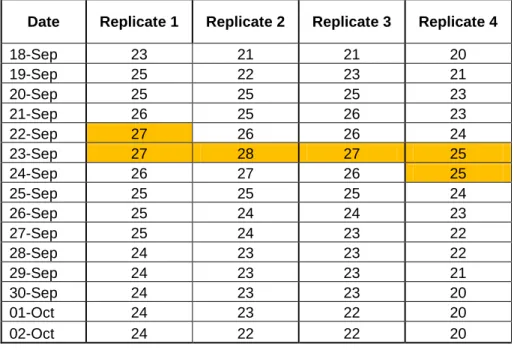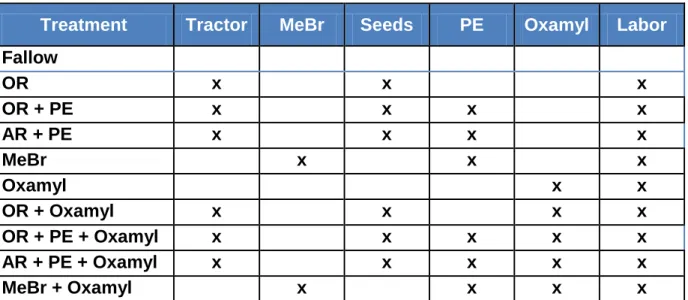The use of biofumigation crops as an alternative to methyl bromide for the control of root knot nematode. However, in light of the global phase-out of methyl bromide, finding efficient and viable alternatives is an essential need. The aim of this study is to evaluate the efficacy of the two biofumigation crops Radish (Raphanus sativus oleifera) and Arugula (Eruca vesicaria sativa), applied with and without plastic sheeting, separately and in combination with Oxamyl in the treatment of root knot nematodes in greenhouse cucumber crops .
Richard El-Riachy who kindly helped me run the experiments and collect the data. Methyl bromide released by human activities was found to be responsible for 5 to 10% of total ozone depletion in the earth's stratospheric layer (MBTOC, 1997). However, a better understanding of the actual effects of green manure crops on root-knot nematodes is needed in order to develop improved management techniques.
Therefore, the objective of this study was to evaluate the efficacy of two biofumigant crops (with and without plastic fabric) separately and in combination with Oxamyl in the management of root-knot nematodes in greenhouse cucumbers.
Reproduction of the root knot nematode in plant roots depends on the ability of the host plant to provide the necessary habitat and energy for the development of the nematode (Fortnum et al., 2000). Better results (up to 96% reduction) were obtained by mixing a much lower ratio (2%) of broccoli tissue along the entire length of the glass tube (Roubstova et al., 2007). The effects of using different types of plastic mulch on nematodes through soil solarization have been investigated.
Plastic mulching of the soil also significantly reduced the population densities of various plant pathogenic nematodes in cucumber crops (Coates-Beckford et al., 1997). An initial soil analysis was done immediately after plowing after the end of the previous tomato harvest to confirm contamination of the soil with root-knot nematodes. An overhead mini-sprinkler system was installed in the greenhouse for irrigating the eight oil radishes of treatments three and four.
Treatment zones (1 to 16) and plants marked (in red) for yield data collection Figure # 7: Methyl Bromide fumigation and covering of oilseed rape crops with plastic. Initial soil samples were taken immediately after plowing the soil following completion of the previous tomato crop to confirm significant soil infestation with root-knot nematodes. A mini-sprinkler system was then installed to irrigate eight plots of oilseed rape and four arugula.
Soil analysis was carried out to determine population levels of the root-knot nematode in the different treatments before and after application. Growth of the oil radish and rucola crops before plowing and working into the soil. Our results indicate that the use of plastic cover with oil radish significantly increases the effectiveness of the isothiocyanates, leading to better control of the root-knot nematode.
Furthermore, shortening the coverage period from 15 to 10 days has no negative effect on the effectiveness of the plastic in combating the root knot nematode. The results of our experiments indicate that using plastic mulch to cover soil treated with oil radish has always increased the effectiveness of this biofumigation crop and led to better control of the root knot nematode. The significant reduction in root galls under the influence of these biofumigation crops also justifies the reduction of the soil population of the previously discussed root knot nematodes.
These results further confirm that oil radish variety "Boss" and arugula can be considered good cover crops and under Lebanese conditions cause a decrease in the root-knot nematode population in the soil and on the roots of greenhouse cucumbers.

Tagetes erecta has shown similar results to taro (Colocastia esculenta) when grown as a ground cover and incorporated into the soil (Sipes and Arakaki, 1997), or when mixed with soybeans (El-Hamawi et al., 2004). Recently, it has also been found important to retain the gases released during the decomposition of the organic matter for at least two weeks to achieve efficient management of the existing pathogens (Garcia-Alvarez et al., 2004). These results confirm the link between soil biological activity and pathogen suppression (Werner and Dindal, 1990; Gamliel and Stapleton, 1993; Scow et al., 1994).
Many researchers attribute the pest suppression effect of biofumigation to the release of volatile gases or to changes in the ratio of pathogenic-antagonistic microorganisms in the soil (Chen et al., 1987; In a recent study on the effect of soil amendment with different rape cultivars, Mojtahedi et al. 1991) have found a direct relationship between the glucosinolate content of the plants used and the control of M. Similarly, with only one exception, all the materials used significantly decreased the index of root galls of tested tomato plants. (PiedraBuena et al., 2006).
Foliar applications of Oxamyl to a local pepper cultivar have resulted in high yield, normal stand and good control of the reniform nematode (Rotylenchus reniformis) (Cruz et al., 1984). Many plants of the brassica family have been reported to suppress populations of root-knot spp. Incorporation of organic material into the soil or biofumigation without the use of any chemical nematicides has produced inconsistent results (Oka et al., 2006).
The three parameters evaluated were the effect of these applications on the nematode population in the soil, root gall index at the end of the growing season and fruit yield. Previous experiments A and B described in chapter I that were carried out under similar conditions (in terms of time of year, biomoisture crops used, cultivar of cucumbers grown and initial soil populations) have already revealed the efficiency of both crops biofumigant (either with or without plastic cover) used in the present experiment reduced soil populations of southern root-knot nematode significantly compared to untreated fallow. Therefore, considering the results of the present experiment, it can be concluded that the addition of Oxamyl to oil radish is not necessary for adequate nematode control in cucumber production in Lebanon.
Therefore, our study confirms that the addition of Oxamyl to biofumigant crops is not as essential as plastic cover to control the southern root-knot nematodes in greenhouse production of cucumber in Lebanon. As such, both oilseed and arugula crops have shown consistent results, significantly reducing the soil population of southern root-knot nematode and root rot and increasing cucumber yields. Increasing incidence and damage of the northern root-knot nematode on onions in New York.
Behavior of the systemic nematicide Oxamyl in plants in relation to the control of the invasion and development of Meloidogyne incognita.
Extensive research for the evaluation of the various chemical and non-chemical control measures in the production of various commercial crops has been carried out. Accurate information on the commercial profitability of using green manure crops alone or in combination with some chemical nematicides for the control of M. C was the total number of plants harvested from the four replicate plots of the same treatment;.
The cost of each treatment calculated separately was added to this constant number to estimate the total production cost related to each treatment. In experiment A, the net profit percentages from both treatments (oil radish and oil radish with plastic cover) have been 123.43% and 218.61%, respectively, compared to methyl bromide (estimated at 100%), whereas the net profit percentage of the untreated fallow has been as low as 10 .44 per cent. After deducting the total cost of production (including processing cost) from the total market value of yield produced by each treatment, it was observed that the net profit percentages obtained from plots treated with oil radish and oil radish with plastic cover were 105.14% and 114.76% respectively compared to methyl bromide.
On the other hand, there is considerably less feeding in the roots of plots treated with methyl bromide (0.7) than with the other treatments (1.7 for arugula with plastic cover, 2.4 for radishes with plastic cover and 4. 7 for radishes without plastic cover). plastic lid) (graph no. 1.4, page 46, chapter I). The net profit loss due to the lack of any soil treatment caused a 32.41% decrease in net profit compared to methyl bromide. Root galling has shown a similar pattern, with significantly less galling found in roots from plots treated with methyl bromide + oxamyl (0.85) than in the other treatments.
In contrast to these findings, the use of plastic mulch with oil radish provides the desired additional control of root-knot nematodes and leads to a reasonable increase in net profit in the production of cucumber plant crops in Lebanon. However, not all farmers are yet well aware of the benefits of the biofumigation technique. This is another factor that prevents farmers from widely using the biofumigation technique.
Reduction of soil populations of the root-knot nematode during decomposition of organic matter. Biofumigation using green manure crops has been one of the potential alternatives proposed by the Methyl Bromide Alternatives Project Lebanon. In addition, this study aimed to assess the economic feasibility of the biofumigation technique with the two crops used and the final profitability of these green manure crops in terms of cost-benefit ratio compared to methyl bromide.
In experiment B, no significant difference in yield nor reduction in nematode population was observed between the two biofumigation crops used with plastic cover and methyl bromide.
